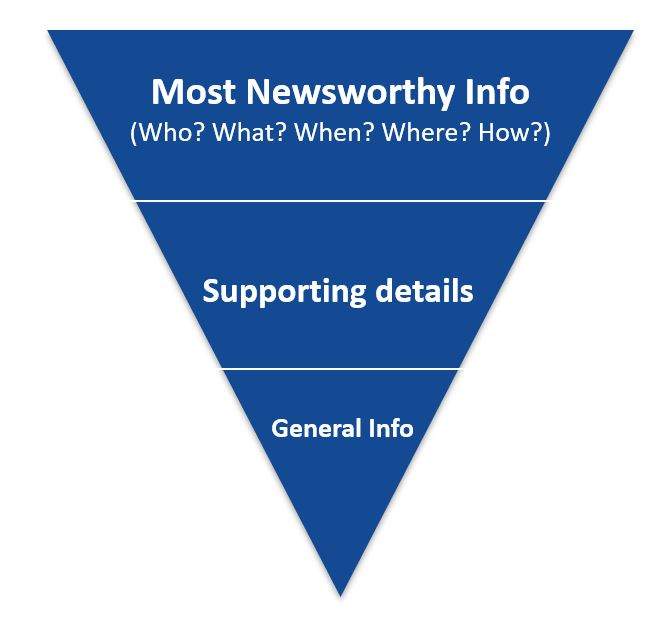Much of the way we work has changed.
For many, the Monday to Friday 9-5 has been replaced by a hybrid model where the working week is split between home and the office.
Some now only go into the office a couple of times a month. And some continue to work remotely.
Yet despite these changes, we still spend much of our work time writing.
We all write emails, for example. And, if anything, we are probably writing and receiving more of them than before.
But many of us also need to write reports, presentations, memos and letters.
Others will need to go further and produce marketing material, product descriptions, blogs and press releases.
Whatever you need to produce, effective writing inspires confidence and adds to credibility - good business writing is an increasingly crucial skill.
And there is one particular structure we believe will significantly improve your business writing skills.
It is called the inverted pyramid, and it is simple to use.
Inverted pyramid
The model may have a slightly mythical-sounding name. But once you are familiar with it, you will notice it everywhere.
It is not a technique taught in school, and it can feel strange when you begin to incorporate it into business communication because it doesn’t mirror the natural structure of conversations.
But it has been used by generations of journalists as the cornerstone of their articles. And it is something we cover during our writing skills training courses.
Let’s take a closer look at it.

When you use the inverted pyramid, the vital part of what you need to say goes at the start – this is sometimes referred to as the ‘lead’.
The idea is to grab attention and hook readers into reading the article.
If you look at a newspaper, the crucial who, what, where, when, why and how questions are answered in the opening paragraphs.
The next stage of the pyramid is where the supporting information is included. Again, if you look at a newspaper story, the middle section – typically referred to as the ‘body’- is filled with quotes, examples, statistics and additional sources.
The length of this part will depend on what you are writing. For detailed reports, it may also include different arguments, evidence and background detail.
And, when you use this model, you finish with additional information. I tend to think of this as the ‘nice to have’ section. The information it contains should be useful rather than essential. It might contain links to additional reading, for example, or contact information.
Why do journalists use this mode?
Well, it acknowledges that readers are often short of time, and it allows them to find the crucial information without having to read the whole article.
And its simplicity ensures stories are easy to follow for readers. If people can’t follow what they are reading, they will quickly lose interest.
It is also used because it means sub-editors – the people who oversee newspaper content, layout and proofreading - should be able to cut the story at any point, from the bottom up to fit a space in the publication, confident it will still make sense to the reader.
Why should you use it?
Ok, you are not a journalist writing for a newspaper.
But you still need to grab interest and attention in the business world. People are busy, impatient, and there is lots of competition for attention. What you have to say can easily be overlooked if it does not hook people in.
The inverted pyramid model also enables brevity. People are not likely to read everything. Many skim-read, and the pyramid immediately gives them the essential information and facts.
It is also easy to follow, which in turn aids comprehension and encourages people to keep reading. Remember, when people can’t follow what is being said, they switch off and stop reading.
And, because it is not widely used outside the media, it will make your business writing stand out from the crowd.
Do you always need to use it?
The inverted pyramid has many benefits as a business writing structure, but you don’t need to use it for everything.
I’ve not used the technique for this blog or any of the other ones I’ve written – a softer, more chatty approach works best for our tone.
There will be times to take more of a storytelling approach.
But I would use it in most things you write - even a detailed business document or report typically needs an executive summary, which naturally lends itself to the inverted pyramid structure.
It is, after all, a structure that has compelled audiences for many decades.
What next? Start trying to use the inverted pyramid in your business writing. If you need a hand, we run writing skills courses, and we can tailor them to your specific aims and needs.
If you need to improve your writing as part of your content marketing strategy, we also offer an online training option, available whenever and wherever you need it.
Media First are media and communications training specialists with more than 35 years of experience. We have a team of trainers, each with decades of experience working as journalists, presenters, communications coaches and media trainers.
Click here to find out more about our writing skills training.
Subscribe here to be among the first to receive our blogs.



